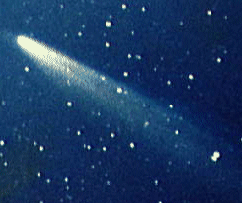 The most prominent part of a comet when seen by naked eye from Earth is the dust tail. Of course, comets generally are invisible except when near the Sun. Most are in highly eccentric orbits around the Sun, which take them way out beyond the orbit of Pluto.
The most prominent part of a comet when seen by naked eye from Earth is the dust tail. Of course, comets generally are invisible except when near the Sun. Most are in highly eccentric orbits around the Sun, which take them way out beyond the orbit of Pluto.
Such long-period comets usually are seen once and then disappear for thousands of years. On the other hand, short-period and intermediate-period comets like Comet Halley stay within the orbit of Pluto for most of their orbits. Pluto is the planet most distant from the Sun.
After it swings in through the inner Solar System and around the Sun a few hundred times, most of a comet's ice and gas will have been lost. That leaves it a rocky object looking very much like an asteroid. Some astronomers say half of the so-called near-Earth asteroids may be "dead" comets.
As you might guess, a comet in an orbit near the Sun might crash into one of the planets or even the Sun itself. On the other hand, the powerful gravitational force of the Sun could fling a comet out of the Solar System altogether.